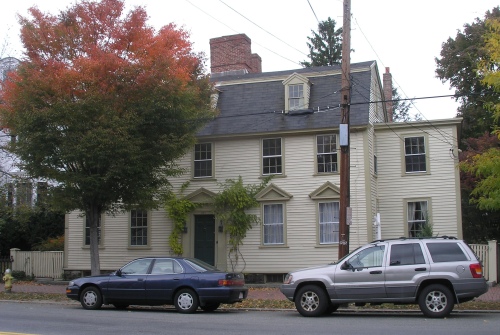Clark-Morgan-Benson House (1729)

Built around 1729, replacing and reusing timbers from a previous house at the same location that had burned, the Clark-Morgan-Benson House is one of the oldest surviving buildings on Essex Street in Salem. Built by Joseph Neal, the house has been enlarged over time and has two substantial ells, forming a U-shape, the ell on the western elevation having a gambrel roof like the front facade. In the nineteenth century, the dwelling was divided between the Clark and Morgan families and was later owned, undivided, for much of the twentieth century by the Benson family.
I have spent the last two years working carefully to preserve, by making relevant, this amazing house. Part of the work was the wiring. A lot of it was a crazed wannabe archeologist creeping around the dark corners of the house. In process, I discovered that the first two floors of the frontal mass of the house is in all likelihood the house purchased by Neal, not a just few recycled timbers.
A rectangular footprint of a very old house is visible from the basement. The rear and right sills (now basement beams) show ancient evidence of foundation contact completing a rectangular footprint under the front of the “L” shaped house. The perimeter of the walls rising from that sill perimeter are timber framed with brick infill, a “high end” practice in the 1600’s (largely ended by the 1700’s) and covered with sheathing and “Clayboards”. The more Georgian “L” running back from the street is entirely without brick infill. Needless to say, interest piqued! Joseph Neal seems to have done a massive Georgian renovation of the house around 1729. No argument. But what happened to the old house? Apparently it hides inside!
Some research using Felt’s mid-nineteenth century “Annals of Salem” gives some clues. Richard Croade, from whose widow Neal purchased the house (? on details of transaction or if another owned it between), moved to Salem from Boston prior to 1676. Probate records show that in 1676 he and a neighbor, Edward Flint handled the estate inventory for John Kitchen, then a recently deceased abutter to the rear of the house. When he arrived, it is recorded that he purchased an existing house and obtained a taverner’s license from Salem.
Why do I believe that the current house contains this original house? The physical framing and brickwork in the walls were a hint. Then I found in the Annals of Salem a list every fire from 1626 through the 19th century. No mention of this house. When I say list of fires, I mean every shed, barn, house, etc. I don’t think this large fancy house on Essex street would have slipped by under the radar. In short, I can’t say how old this house is, but in my opinion, evidence indicates it is much older than 1729. And this was at a stage of our history when 30 or 40 years was the difference between Medieval and Enlightenment.
I know, a lot of info. I have put a bit of thought into it. But if I’m right, a solid piece of Salem History is hiding quietly, and would love to see the light of day.